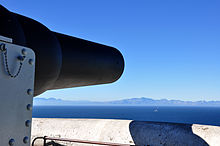False Bay
In plan the bay is approximately square, being roughly the same extent from north to south as east to west, with the southern side open to the ocean.
The continental shelf is at its widest in this ecoregion, extending up to 240 km (150 mi) offshore on the Agulhas Bank, but is considerably narrower off False Bay.
[4] In plan the bay is approximately square with rather wobbly edges, being roughly the same extent from north to south as east to west (30 km), with the entire southern side open to the ocean.
The main exception is a long ridge of sedimentary rock that extends in a southward direction from off the Strand, to approximately level with the mouth of the Steenbras River.
Most of these reefs on the western side of the bay are granite of the Peninsula pluton, but east of Seal Island they are generally sandstone, either of the Table Mountain series, or of the underlying Tygerberg formation.
[5][9][4] Whittle Rock reef can refract large south easterly storm waves, increasing their size in the vicinity of Kalk Bay harbour.
[11]: Ch2 Outside the bay, but influencing the wave patterns in it, is Rocky Bank, an extensive area of relatively flat sandstone reef between 20 and 30 m depth on the top, sloping down on all sides, but mostly to the south and east, where the depth can exceed 100 m.[5][4] A long underwater sandstone ridge sweeps across the eastern side of the mouth from Cape Hangklip towards the southwest, that is believed to affect water circulation in the bay.
The prevailing swell is about 12 to 25 second period from the southwest with average height of about 3 m. It impinges directly on the east coast of the bay, amplified by refraction over Rocky Bank in the region near the Steenbras River mouth, where rogue waves may occur.
Further west the swell refracts and diffuses around a fairly large shoal area around Cape Point, and is moderately to severely attenuated by the time it reaches the western shores.
There are cold-water upwelling events associated with south-easterly winds in summer, and periodic intrusions of warm water eddies from the Agulhas Current of the south coast, both of which contribute to the biodiversity.
[18]: 10 In the summer to early autumn (January–March), cold water upwelling near Cape Hangklip causes a strong surface temperature gradient between the south-western and north-eastern corners of the bay.
It is joined by minor tributaries from Landdroskloof and Sneeukopkloof in its upper reaches, The river flows in a south-westerly direction between the Helderberg and Schapenberg through Somerset West and Strand to a small estuary on the coast of False Bay.
Demersal trawling, purse seining and gillnetting were introduced in the 19th century, but have been stopped as they were depleting stocks, conflicting with other fisheries and users, and damaging the environment.
[10] Over the years, a number of ships have been wrecked in False Bay, due to weather, war, errors in navigation, other accidents, or intentional scuttling.
The La Niña phase of the El Niño–Southern Oscillation cycle tends to increase rainfall in this region in the dry season (November to April).
[10] The South Atlantic high shifts latitude with the seasons, following the sun, and this causes a large variation in the wind pattern over the passage of the year.
A government appointed panel has reported that the appearance of orcas, commercial fishing, and climate change are likely the major contributing factors to the mass exodus of the sharks.
[63] The seaweed ecology is unusually varied for an area of this size, as a result of the meeting of two major oceanic water masses near Cape Point, comprising two coastal marine bioregions.
[10] Brown discoloration in the surf zone along the north shore is frequently due to persistent blooms of the non-toxic diatom Anaulus australis, which is provided with nutrients from groundwater seepage through the sand bottom and river outfalls containing waste water from the nearby sewage purification systems.
In the last decade of the 20th century linefish catches along the South African coast declined to the extent that emergency measures were declared to protect the remaining stock.
Snoek and harder are an important part of the informal trade system in the traditional fishing communities, and contribute towards local food security.
[10] Other invertebrates that are harvested in the bay under the permit system include mussels and clams, giant turban shells (alikreukel) and various limpets.
The marina at Harbour Island in Gordon's Bay is protected against swells from all directions, but the entrance and inshore approaches are exposed to large south-westerly seas.
[73][74] Tourism relating to False Bay makes a significant contribution to the region's economy, providing revenue from whale watching, shark-cage diving and other water sports.
[78] The tourist attraction of shark cage diving has ceased in recent years without the appearance of great whites, impacting the local economy.
During the Second World War many heavy guns were mounted in concrete bunkers at various points along the mountainous shores of False Bay in order to deter attacks on Simon's Town.
Lower North battery at the bottom of Redhill road is used for naval gunnery training and has a few examples of currently used weapon systems for this purpose.
The nitroglycerine plant at this installation blew up twice in the second half of the 20th century and sent massive shockwaves across the bay, breaking windows and rattling walls on the distant shores.
The ecosystem has shifted as a result, with typical west coast species like kelp and rock lobsters expanding their ranges and populations eastwards.
[10] The rising sea level is cutting back the coastline near Macassar beach during high swell events at a rate in the order of 2 m per year.















